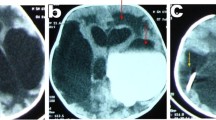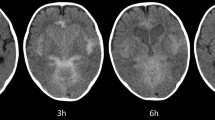Abstract
Post-tubercular meningitic hydrocephalus (TBMH) and post-traumatic hydrocephalus (PTH) is often considered a contraindication for endoscopic third ventriculostomy (ETV), as it is mostly of communicating type in these cases. The aim of the present study was to define the role of ETV in patients with communicating hydrocephalus. Ten consecutive patients of TBMH, PTH and postneurocysticercus (NCC) hydrocephalus were formed the study group. Diagnosis of communicating hydrocephalus was made using magnetic resonance ventriculography (MRV). If contrast was seen coming out from the ventricular system into the basal cisterns, it was considered as communicating hydrocephalus. Patients with clinical and imaging evidence of raised intracranial pressure and failed medical treatment were taken up for ETV. All patients were studied by preoperative and postoperative MRV. Success of the procedure was assessed by the improvement in clinical and imaging parameters on postprocedure follow-up in all these cases. Technically successful ETV was performed in all 10 patients. Overall success rate of ETV in communicating hydrocephalus was 70% (n = 7). The shunt surgery was performed in the remaining three patients with ETV failure. One patient developed complication following postoperative MRV and was managed conservatively. We conclude that ETV is effective in post-TBM, post-traumatic communicating and post-NCC communicating hydrocephalus and should be considered as initial surgical option for cerebrospinal fluid diversion in these patients. MRV is a relatively safe technique to ascertain the patency of subarachnoid space as well as ETV stoma.



Similar content being viewed by others
References
Aquilina K, Edwards RJ, Pople IK (2003) Routine placement of a ventricular reservoir at endoscopic third ventriculostomy. Neurosurgery 53:91–97
Brockmeyer D, Abtin K, Carey L, Walker M (1998) Endosopic third ventriculostomy: an outcome analysis. Pediatr Neurosurg 28:236–240
Cinalli G (1999) Alternatives to shunting. Childs Nerv Syst 15:718–731
Cinalli G, Sainte-Rose C, Chumas P, Zerah M, Brunelle F, Lot G, Pierre-Kahn A, Renier D (1999) Failure of third ventriculostomy in the treatment of aqueductal stenosis in children. J Neurosurg 90(3):448–454
Figaji AA, Fieggen AG, Peter JC (2003) Endoscopic third ventriculostomy in tuberculous meningitis. Childs Nerv Syst 19:217–225
Figaji AA, Fieggen AG, Peter JC (2005) Air encephalography for hydrocephalus in the era of neuroendoscopy. Childs Nerv Syst 21:559–565
Foroutan M, Mafee MF, Dujovny M (1998) Third ventriculostomy, phase-contrast cine MRI and endoscopic techniques. Neurol Res 20(5):443–448
Frim DM, Goumnerova LC (1997) Telemetric intraventricular pressure measurements after third ventriculocisternostomy in a patient with non communicating hydrocephalus. Neurosurgery 41:1425–1428
Fukuhara T, Vorster SJ, Luciano MG (2000) Risk factors for failure of endoscopic third ventriculostomy for obstructive hydrocephalus. Neurosurgery 46:1100–1111
Fukuhara T, Vorster SJ, Ruggieri P, Luciano MG (1999) Third ventriculostomy patency: comparison of findings at cine phase-contrast MR imaging and at direct exploration. AJNR Am J Neuroradiol 20:1560–1566
Gangemi M, Maiuri F, Buonamassa S, Colella G, de Divitiis E (2004) Endoscopic third ventriculostomy in idiopathic normal pressure hydrocephalus. Neurosurgery 55:129–134
Goumnerova LC, Frim DM (1997) Treatment of hydrocephalus with third ventriculocisternostomy: outcome and CSF flow pattern. Pediatr Neurosurg 27:149–152
Govindappa SS, Narayanan JP, Krishnamoorthy VM, Shastry CH, Balasubramaniam A, Krishna SS (2000) Improved detection of intraventricular cysticercal cysts with the use of three-dimensional constructive interference in steady state MR sequences. AJNR Am J Neuroradiol 21:679–684
Greitz D (2004) Radiological assessment of hydrocephalus: new theories and implications for therapy. Neurosurg Rev 27(3):145–165
Greitz D (2007) Paradigm shift in hydrocephalus research in legacy of Dandy's pioneering work: rationale for third ventriculostomy in communicating hydrocephalus. Childs Nerv Syst 23:487–489
Greitz D, Hannerz J (1996) A proposed model of cerebrospinal fluid circulation: observations with radionuclide cisternography. Am J Neuroradiol 17:431–438
Hirsch JF, Hirsch E, Sainte-Rose C, Renier D, Pierre-Kahn A (1986) Stenosis of the aqueduct of Sylvius: aetiology and treatment. J Neurosurg Sci 30:29–39
Hopf NJ, Grunert P, Fries G, Resch KDM, Perneczky A (1999) Endoscopic third ventriculostomy: outcome analysis of 100 consecutive patients. Neurosurgery 44(4):795–803
Husain M, Jha D, Rastogi M, Husain N, Gupta RK (2005) Role of neuroendoscopy in the management of patients with tuberculous meningitis hydrocephalus. Neurosurg Rev 56:278–283
Husain M, Jha D, Thaman D, Husain N, Gupta RK (2004) Ventriculostomy in a tumor involving the third ventricular floor. Neurosurg Rev 27(1):70–72
Husain M, Jha D, Vatsal DK, Thaman D, Gupta A, Husain N, Gupta RK (2003) Neuroendoscopic surgery—experience and outcome analysis of 102 consecutive procedures in a busy neurosurgical centre of India. Acta Neurochir (Wien) 145(5):369–376
Jack CR Jr, Kelly PJ (1989) Stereotactic third ventriculostomy: assessment of patency with MR imaging. AJNR Am J Neuroradiol 10:515–522
Jones RF, Kwock BC, Stening WA, Vonau M (1994) The current status of endoscopic third ventriculostomy in the management of non-communicating hydrocephalus. Minim Invasive Neurosurg 37:28–36
Jones RF, Stening WA, Brydon M (1990) Endosopic third ventriculostomy. Neurosurgery 26:86–92
Joseph VB, Raghuram L, Korah IP, Chacko AG (2003) MR Ventriculography for the study of CSF flow. AJNR Am J Neuroradiol 24:373–381
Kunz U, Goldman A, Barder C, Waldbaur H, Oldenkott P (1994) Endoscopic fenestration of the third ventricular floor in aqueductal stenosis. Minim Invasive Neurosurg 1975:42–47
Lev S, Bhadelia RA, Estin D, Heilman CB, Wolpert SM (1997) Functional analysis of third ventriculostomy patency with phase-contrast MRI velocity measurements. Neuroradiology 39:175–179
Mitchell P, Mathew B (1999) Third ventriculostomy in normal pressure hydrocephalus. Br J Neurosurg 13:382–385
Mohanty A, Vasudev MK, Sampath S, Radhesh S, Kolluri VRS (2002) Failed Endoscopic Third Ventriculostomy in Children: Management Options. Pediatr Neurosurg 37:304–309
Oka K, Yamamoto M, Ikeda K, Tomonaga M (1993) Flexible endoneurosurgical therapy for aqueductal stenosis. Neurosurgery 33:236–242
Rapana A, Bellotti A, Iaccarino C, Pascale M, Schonauer M (2004) Intracranial pressure patterns after endoscopic third ventriculostomy preliminary experience. Acta Neurochir (Wien) 146:1309–1315
Ray DE, Cavanagh JB, Nolan CC, Williams SCR (1996) Neurotoxic effects of gadopentetate dimeglumine: behavioural disturbance and morphology after intracerebroventricular injection in rats. Am J Neuroradiol 17:365–373
Scarrow AM, Levy EI, Pascucci L, Albright AL (2000) Outcome analysis of endoscopic III ventriculostomy. Childs Nerv Syst 16:442–445
Schwartz TH, Yoon SS, Cutruzzola FW, Goodman RR (1996) Third ventriculostomy: postoperative ventricular size and outcome. Minim Invasive Neurosurg 39(4):122–129
Siebner HR, Grafin von Einsiedel H, Conrad B (1997) Magnetic resonance ventriculography with gadolinium DTPA: report of two cases. Neuroradiology 39:418–422
Singh D, Sachdev V, Singh AK, Sinha S (2005) Endosopic third ventriculostomy in post-tubercular meningitic hydrocephalus: a preliminary report. Minim Invasive Neurosurg 48:47–52
Siomin V, Cinalli G, Grotenhuis A, Golash A, Oi S, Kothbauer K, Weiner H, Roth J, Beni-Adani L, Pierre-Kahn A, Takahashi Y, Mallucci C, Abbott R, Wisoff J, Constantini S (2002) Endoscopic third ventriculostomy in patients with cerebrospinal fluid infection and/or hemorrhage. J Neurosurg 97:519–524
Skalpe IO, Tang GJ (1997) Magnetic resonance imaging contrast media in the subarachnoid space: a comparison between gadodiamide injection and gadopentetate dimeglumine in an experimental study in pigs. Invest Radiol 32:140–148
Smyth MD, Tubbs RS, Wellons JC III, Oakes WJ, Blount JP, Grabb PA (2003) Endoscopic third ventriculostomy for hydrocephalus secondary to central nervous system infection or intraventricular haemorrhage in children. Pediatr Neurosurg 39:258–263
Turgut Tali E, Ercan N, Krumina G, Rudwan M, Mironov A, Yu Zeng Q, Jinkins JR (2002) Intrathecal gadolinium (gadopentetate dimeglumine) enhanced magnetic resonance myelography and cisternography: results of a multicenter study. Invest Radiol 37:152–159
Zeng Q, Xiong L, Jinkins JR, Fan Z, Liu Z (1999) Intrathecal gadolinium-enhanced MR myelography and cisternography: a pilot study in human patients. AJR Am J Roentgenol 173:1109–1115
Author information
Authors and Affiliations
Corresponding author
Additional information
Comments
Nikolai Hopf, Stuttgart, Germany
The authors describe 10 patients with communicating hydrocephalus treated by endoscopic third ventriculostomy (ETV). Communicating hydrocephalus was caused by trauma, tubercular meningitis or neurocysticercosis.
All patients had MR ventriculography before and after ETV. Seven patients were treated successfully, based on clinical findings and MRI. The others show nicely the usefulness of MR-ventriculography for indication and outcome of ETV, even though their technique of performing it under general anesthesia and repetitive puncturing of the ventricle via the same burr hole seams associated with an additional risk of infection and not applicable to a large patient population. But it is certainly a very valuable investigation in patients with not accepted indication for ETV or nonconclusive MRI findings.
My concern with this paper is the definition of communicating hydrocephalus. The others define it by MR ventriculography when the contrast medium exits the fourth ventricle but stays in the cisterns of the posterior fossa. Patients with further spread of the contrast were excluded (two patients).
In all treated patients (10 patients), CSF did obviously not reach the region of CSF reabsorption. Therefore this type of hydrocephalus should be categorized as noncommunicating. It is well-known that ETV is successful whenever a formerly nonexisting access to the convexity can be created and reabsorption is not impaired. However the paper most importantly demonstrates that patients with posttraumatic, postmeningitic, and hydrocephalus from neurocysticercosis may profit from ETV, if an obstruction of the CSF pathway is present. This can nicely be demonstrated by MR ventriculography. But it is certainly not correct, based on this paper, to conclude that communicating hydrocephalus can be treated successfully by ETV.
Rights and permissions
About this article
Cite this article
Singh, I., Haris, M., Husain, M. et al. Role of endoscopic third ventriculostomy in patients with communicating hydrocephalus: an evaluation by MR ventriculography. Neurosurg Rev 31, 319–325 (2008). https://doi.org/10.1007/s10143-008-0137-5
Received:
Revised:
Accepted:
Published:
Issue Date:
DOI: https://doi.org/10.1007/s10143-008-0137-5




